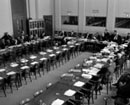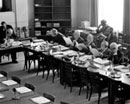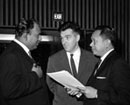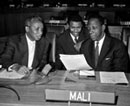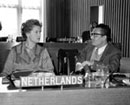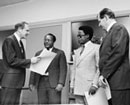|
Vienna Convention on Consular Relations
Vienna, 24 April 1963
By Juan Manuel Gómez Robledo
Deputy Foreign Minister for Multilateral Affairs and Human Rights Ministry of Foreign Affairs, Mexico
Historical Context
The history of the consular function is largely associated with the development of international trade and the economic interest of States. While the origins of the consular institution can be traced back to ancient Greece, it was not until the twelfth century that the first figure of the consul emerged and developed to its present and more complex structure. In addition, the earliest codes on consular duties were developed throughout the same period, mostly in the form of maritime law compilations. In the sixteenth and seventeenth centuries, with the foundation of the diplomatic missions in Europe and its subsequent proliferation, a significant shift in consular powers came about, culminating with the publication of the first collection of consular rules (Ordonnance de la Marine, Colbert, 1681). The extraordinary increase of consulates during the nineteenth and twentieth centuries revealed the need for a more precise legal framework, particularly concerning the consular service and the legal status of consuls. Later on, the vertiginous changes in social, political and economic activity, as well as the increasing global trends affecting daily life impinged a new challenge for the consular institution: the protection of citizens and the safeguard of their interests. Some preliminary attempts at the official codification of international consular legislation resulted in the adoption of regional agreements, preceding the pioneer work carried out by the League of Nations on the subject. In spite of the League of Nations’ conclusions regarding not only the desirability, but the paramount importance of consular regulation through international instruments, the issue was left pending for nearly twenty years. In 1949, the United Nations International Law Commission considered the inclusion of consular intercourse and immunities as part of its future codification work. At its seventh session, held at Geneva, Switzerland, from 2 May to 8 July 1955, the Commission appointed Mr. Jaroslav Zourek as Special Rapporteur to commence the review of the matter and draft a set of provisional rules, based on jus cogens, national and international law. The discussion did not formally start until 1958. The draft set of rules were later divided into four chapters (consular intercourse and immunities; consular privileges and immunities; legal status of honorary consuls and their privileges and immunities; and general provisions), and, accompanied by commentaries, submitted to Member States for their observations at different stages of the negotiation. At its twelfth session held from 25 April to 1 July 1960, the Commission determined that articles referring to career consuls should also be applicable to honorary consuls. Consequently, the Commission included more comprehensive provisions and inserted some new articles, before provisionally adopting the draft articles and commentaries. The numerous similarities of the subject to that of diplomatic immunities and intercourse led to the adoption of an accelerated procedure by the Commission on the topic. The 71 draft articles were then submitted to the United Nations General Assembly for information purposes and the vast majority of States decided that they should form the basis of a multilateral instrument codifying consular law. With a view to adopting a convention on the subject, the Commission recommended that the United Nations General Assembly convene an international conference of plenipotentiaries in March 1963. The United Nations Conference on Consular Relations was held in Vienna, Austria, from 4 March to 22 April 1963 and was attended by delegates of ninety-five States. After careful consideration of the International Law Commission’s text, the final version was prepared for submission to the plenary. On 24 April 1963, the Conference adopted and opened for signature the Vienna Convention on Consular Relations, the Optional Protocol concerning Acquisition of Nationality and the Optional Protocol concerning the Compulsory Settlement of Disputes. The Convention and both Optional Protocols came into force on 19 March 1967. The Vienna Convention consists of 79 articles, most of which provide for the operation of consulates; outline the functions of consular agents; and address the privileges and immunities granted to consular officials when posted to a foreign country. A few other articles specify consular officials’ duties when citizens of their country face difficulties in a foreign nation. Of particular interest for the right of individuals is article 36, providing for certain obligations for competent authorities in the case of an arrest or detention of a foreign national, in order to guarantee the inalienable right to counsel and due process through consular notification and effective access to consular protection. In recent years, the right to consular notification and access provided for in the Vienna Convention has increasingly been raised in proceedings not only at the domestic and regional levels, but also in international courts. The first United States case relating to article 36 of the Vienna Convention was Breard v. Greene (523 U.S. 371, 1988), followed by numerous claims in United States federal circuit courts of appeals, state supreme courts, and the United States Supreme Court. Interpretations have varied widely, from the non-recognition of fundamental rights conferred by article 36, where no appropriate remedy is available, to the possibility of individually enforcing those rights. In 1999, the Inter-American Court of Human Rights issued an advisory opinion, recognizing that article 36 creates individual rights, as a “notable exception to what are essentially States’ rights and obligations accorded elsewhere” in the Convention (Advisory Opinion of the Inter-American Court of Human Rights: Due Process of Law is a Fundamental Right (OC-16/99), para. 82). In 2001, the International Court of Justice in LaGrand (Germany v. United States of America) found that where a violation of article 36 occurs, a remedy is due consisting of “review and reconsideration by United States courts of convictions and sentences”, in light of the breach of the Convention. The Avena and other Mexican Nationals case (Mexico v. United States of America) marked a turning point regarding article 36 jurisprudence. The International Court of Justice’s unprecedented decision of 2004 expressly recognized the interdependence of both individual and State’s rights, by asserting that “violations of the rights of the individual under article 36 may entail a violation of the rights of the sending State, and that violations of the rights of the latter may entail a violation of the rights of the individual” (I. C. J Reports 2004, p. 36). Moreover, the Court stated that the fact that in this case the ruling concerned only Mexican nationals cannot be taken to imply that the conclusions reached by it in the Avena case do not apply to other foreign nationals finding themselves in similar situations in other countries. These cases may eventually carry significant consequences for countries legally imposing the death penalty: “That is, only where the most rigorous standards of fairness and legality of international jurisprudence are scrupulously followed.” (Catherine M. Amirfar, “The Avena Case in the International Court of Justice”, in German Law Journal No. 4, April, 2004.)
This Introductory Note was written in September 2008.
Related Materials
At its first session, in 1949, the International Law Commission selected the subject of consular intercourse and immunities as one of the topics for codification without, however, including it in the list of topics to which it gave priority. In 1955, the Commission decided to begin the study of this topic and appointed Jaroslav Žourek as Special Rapporteur. The Commission considered this topic in 1956 and from 1958 to 1961. In connection with its work on this topic, the Commission had before it the reports of the Special Rapporteur (A/CN.4/108, A/CN.4/131 and A/CN.4/137) and information provided by Governments (A/CN.4/136 and Adds.1-11). In 1960, the Commission adopted on first reading sixty-five draft articles, together with commentaries, and transmitted the draft to Governments for their comments. In 1961, the Commission adopted a final draft on consular relations, consisting of seventy-one articles accompanied by commentaries. In submitting the final draft to the General Assembly, the Commission recommended that the Assembly convene an international conference of plenipotentiaries to study the draft and conclude one or more conventions on the subject. The General Assembly, in resolution 1685 (XVI) of 18 December 1961, noted “with satisfaction that the draft articles on consular relations prepared by the International Law Commission constitute a good basis for the preparation of a convention on that subject”, decided that an international conference of plenipotentiaries should be convened at Vienna at the beginning of March 1963, and referred to the Conference the report adopted by the ILC containing draft articles on consular relations. At the same time, in order “to provide an opportunity for completing the preparatory work by further expressions and exchanges of views concerning the draft articles at the seventeenth [1962] session”, the Assembly also requested Member States to submit written comments on the draft articles, by 1 July 1962, for circulation to Governments prior to the beginning of the seventeenth session, and decided to place on the provisional agenda of that session the item “Consular relations”. In 1962, after a discussion on the draft articles on consular relations in the Sixth Committee, the General Assembly, by resolution 1813 (XVII) of 18 December 1962, requested the Secretary-General to transmit to the conference of plenipotentiaries the summary records and documentation relating to the consideration of this item at the Assembly’s seventeenth session, and invited States intending to participate in the conference to submit to the Secretary-General as soon as possible, for circulation to Governments, any amendment to the draft articles which they might wish to propose in advance of the conference. The United Nations Conference on Consular Relations, which was attended by delegates of ninety-five States, met at Vienna from 4 March to 22 April 1963. The Conference assigned consideration of the draft articles prepared by the International Law Commission, and certain additional proposals, to two main committees, each composed of all the participating States. After the articles and proposals had been dealt with in the main committees, they were referred to a drafting committee, which prepared texts for submission to the Conference meeting in plenary session. The Conference adopted the Vienna Convention on Consular Relations, consisting of seventy-nine articles, an Optional Protocol concerning Acquisition of Nationality and an Optional Protocol concerning the Compulsory Settlement of Disputes. The Final Act of the Conference was signed on 24 April 1963. The Convention and Optional Protocols remained open for signature until 31 October 1963 at the Federal Ministry for Foreign Affairs of Austria and subsequently, until 31 March 1964, at United Nations Headquarters. They remain open for accession by all Members of the United Nations or of any of the specialized agencies or Parties to the Statute of the International Court of Justice, and by any other State invited by the General Assembly to become a party. The Convention and both Optional Protocols came into force on 19 March 1967. Text of the Convention Selected preparatory documents Report of the International Law Commission on the work of its first session, 12 April 1949 (A/CN.4/12 and Corr. 1-3, reproduced in Yearbook of the International Law Commission, 1949, vol. I, Part One, Chapter II) The Convention entered into force on 19 March 1967. For the current participation status of the Convention, as well as information and relevant texts of related treaty actions, such as reservations, declarations, objections, denunciations and notifications, see:
|



